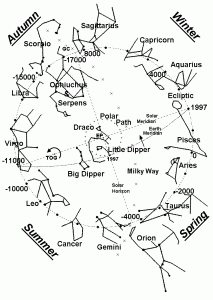 This is a continuation of my series on the supposed changes in the Zodiac and claiming your personal responsibility in weighing the relativity of conceptual knowledge. How Saturn in Libra is that!
This is a continuation of my series on the supposed changes in the Zodiac and claiming your personal responsibility in weighing the relativity of conceptual knowledge. How Saturn in Libra is that!
Peruse previous posts here.
Let’s return to our original idea from part 1. When we draw the ecliptic (that line that the Sun appears to travel along) on the sky, we cut through several “constellations.” Well, this begs the question “What is a constellation?”
Casually speaking a constellation is a “group of stars.” (Technically speaking, the term constellation currently refers to an internationally agreed upon space boundary. But for now, let’s just talk about them in terms of star groupings.)
…and a “group” is just an idea. It is a projected connection made up in our minds. You guys know there are not actual strings tying the stars of a constellation together like pieces of cosmic caution tape, right? The constellations are the pictures that resulted from bored shepherds and lost sailors playing connect the dots on the sky.
Here’s a fun experiment. Take a sheet of paper and draw a bunch of dots all over it. Next, make a few photocopies of that sheet. Give your friends a copy with a pen and ask them without looking at their neighbor’s paper, to connect some of the dots to make a picture. Unless your friends are psychic twins, the results should be different.
Now, some of the stars in the sky are close together and make “obvious groups.” So, that your friends might trace out a similar configuration. The biggest difference in this case would be the interpretation. “I see a swallow!” compared to “I see a pair of fish.”
But more of the groups are less obvious. The stars are blobbed on the sky in such a way that the demarcations have more possibilities. “I see a giant scorpion with magnificent claws!” compared to “I see a set of scales. Oh, and a bug next to it.” One person sees one giant blob, another sees two smaller blobs.
Eventually for practical purposes, the shepherds, the sailors and other star gazers got together to agree on which pictures to use so they could share ideas about space, time, planetary motion and navigation more easily. Now since this was before the Internet, different groups of star gazers got together in different parts of the world and came up with different ideas. Different collections of agreed upon pictures were formed. The predominant collection of constellations used today comes down from the Greek retweaking of the Babylonian systems. The constellations most of us know are part of the Western sky culture.
But I digress… today’s main idea is that these star groups are arbitrary.
Hold onto that idea, come back tomorrow and I might make a point or two about something relevant to our original question.
Read What’s an Ophiuchus: Part 2
Click here to schedule a consult with Nota
You can also follow her on Twitter.


“Hold onto that idea, come back tomorrow and I might make a point or two about something relevant to our original question.”
Hahaha! I am really enjoying your beginners’ articles, Nota. Accessible and entertaining. Thank you.
:)) I am really enjoying these articles too
LOVE the idea: weighing the relativity of conceptual knowledge.
and as you point out, everything is a concept – the idea of a group or clustering, is also a concept. plato and the forms and all that jazz.
from a more mystical perspective – the fact that we all still feel like our own sign, identify with our signs and see them in ourselves (to the extent that we do), and see in others (again, to an extent) –
supposing our intuition to be valid and true, especially intuition confirmed by experience (which for many/most of us, astrology is)
Supposing our intuition to be valid and true,
suppose the constellations are symbols that help us organize a collection of experiences which go into a (our own personal) human-nature-reading catalog grand algorithm in our heads –
collections of psychological- emotional- and intellectual observations of human expression and being cataloged our grouped into a system
…
in the scientific sense, we can observe the motions of planetary bodies (with no respect whatsoever to homo sapiens’ may auger over their motion and transits), and observe what it is we see through a telescope and describe it. We try to tell in as plain language as possible what it is we see and observe.
000
is it just me, or is the idea of “adding a 13th planet” a bit like saying we’re at the 13th hour?
Nota: “come back tomorrow and I might make a point or two about something relevant to our original question”.
And even if you don’t, you’ll still be very entertaining anyway :o)!
Angie
also — is this a pluto in capricorn upheaval of astrology’s authority?
sweet nota thanks!
Thanks everybody. I’m glad you’re enjoying these articles. I’m enjoying writing them.
If you really like what we do here, the best way to show it is to pass it along. Send a link to your friends and help this site grow.
Krustallos, is it like saying we’re at the 13th hour?
Yes and No.
(Maniacal Laughter) I love being a Libra.
Wow, I’ve really enjoyed your tutorial on the constellations.
“today’s main idea is that these star groups are arbitrary.”
I would argue, arbitrary to a point. That point being the ability to throw up our mythic collective unconscious upon the screen of the night’s sky and get a resonance. —And that is such beauty for me, the awe of how it all fits together.
krustallos, thank you for your meanderings. I sometimes feel why not 13 suns and 13 moons at this 13th hour? I mean, no matter how exquisite the astrolabes from the Renaissance, they got it wrong…and took centuries to make their apologies. At the same Libran time the point mistyoga makes about the mythic collective unconscious being primordially powerful is equally weighty.
I am enjoying this investigation without ego.
Thank you Nota